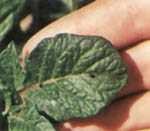The potato flea beetle is primarily a pest of potato but it also attacks cucumber, eggplant, pepper, tomato and such other plants as jimsonweed, tobacco, large white petunia, groundcherry and bittersweet.
Identification
The potato flea beetle is primarily a pest of potato but it also attacks cucumber, eggplant, pepper, tomato and such other plants as jimsonweed, tobacco, large white petunia, groundcherry and bittersweet.
Identification

The potato flea beetle adult is small, 1.7 mm in length and 1 mm wide. It is black with brown legs and antennae. The beetles jump actively, particularly when disturbed, but they do not fly. They may be found on all above-ground parts of the potato plant as well as on the soil surface. They feed on both the upper and lower leaf surfaces, but more frequently on the upper surface.
The larva is a slender white grub with a dark brown head and minute legs. When full-grown, it is about 5 mm in length. As a rule, larvae inhabit the soil around potato roots. On occasion, they may enter the tubers, in which case the tuber displays small pimples or hollows at the point of entry and the tunnels are filled with corky tissue.
Life History
This beetle has one generation per year. Adults overwinter at the soil surface among litter or undergrowth either in, or close to, the potato fields in which the adults fed during the previous summer. In spring, adults move to potato fields where they feed on the foliage of newly-emerged potato plants. If potato crops have not yet emerged, the beetles feed on weeds or volunteer plants. In potato fields, females lay eggs in the soil surrounding potato plants. After laying eggs, the overwintered adults die. Usually all overwintered adults are dead by the time of first bloom of potato plants.
Larvae hatch about one week after the eggs are laid, feed primarily upon the finer roots of potato plants, complete development in about 4 to 5 weeks, then pupate in the soil. The pupal stage lasts about one week. Adults emerge from the soil, usually in late July or August, and feed on potato leaves. The density of adults rises rapidly during emergence, reaching a peak in August. Feeding continues on potato leaves until adults enter overwintering sites.
Crop Injury
Feeding injury, whether by adults on potato leaves in spring or late summer, or by larvae on tubers and roots and transmission of plant pathogens, are all potential ways in which this flea beetle may reduce potato yields both in terms of quality and quantity. Adult feeding on leaves results in rounded feeding scars, 0.1 to 5 mm in diameter, which usually penetrate through the leaf to form a hole. When the beetle is abundant, potato leaflets eventually exhibit a "shot-holed" appearance. Direct damage to tubers by this flea beetle is minor; it can usually be removed by peeling the tubers.
Early-season feeding by the adult is not normally considered significant probably because control measures against Colorado potato beetle also kill the flea beetle. Adult late-summer feeding in areas where potato crops do not receive insecticide late in the season can cause significant damage.
In some years in some areas of the Maritimes, control of this flea beetle is definitely justified on economic grounds. Diseases reported to be associated with this beetle include verticillium wilt, fusarium dry rot and rhizoctonia, as well as common scab.
Pest Management
Monitoring - Large numbers of beetles late in the season could reduce yields in some varieties.
Cultural Practices - This flea beetle tends to be more abundant in those parts of potato fields that are adjacent to uncultivated areas. In such places, the vegetation provides food for the beetles. It also retains snow which, by insulating the overwintering beetles from severe cold, may enhance their survival. Because the adult of this flea beetle does not fly, separation of uncultivated areas from potato fields may reduce populations in potato fields. Control of volunteer potato and of alternate hosts may also be used to starve overwintered adults in the spring before potato crops emerge.
Resistant Varieties - Some varieties, because of their vigour can probably tolerate more injury.
Chemical Control - Potato plants are treated with insecticides aimed at a variety of other insect pests. In most cases, those insecticides also control flea beetles so that, in many regions, specific applications against this flea beetle are uncommon. Insecticides recommended against emerging adults should be applied about two weeks after the first adults appear.